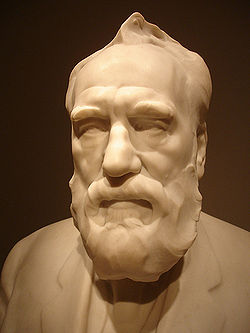Course:ETEC540/2010WT1/Assignments/ResearchProject/InventionOfTelephone
Authored by Melanie Wong (2010)

Introducing the Telephone
The Telephone was invented by Alexander Graham Bell in 1876 (Flood, 1976). However, the foundations for the invention began in 1837 with Charles Pages’work on magnetism and sound. In 1870 Varley continued this introductory work with his discovery of how a magnet could be polarized to increase the sensitivity of a receiver.
Bell’s invention was not without controversy. After filing his application for a patent in 1876, a similar application was filed by Elisha Gray on the same day. Because Bell’s application was more complete, he was granted the patent over Gray.
Implications of the Telephone historically and culturally
Prior to the invention of the telephone, there had been various forms of communication introduced. In 1835, Samuel Morse invented “Morse Code” (Bellis, 2010b). Earlier Joesph Henry in 1831 had invented the first electric telegraph. Henry’s invention of the telegraph was significant to Bell’s work as it provided Bell with a platform that lend him to the discovery of the telephone (Bellis, 2010a). Bellis (2010a) recounts how Bell had been seeking to improve the design of the telegraph when he stumbled upon his invention of the telephone. The telegraph had been limited in nature as it only allowed an individual to send one message at a time. The telegraph technology was significant as it allowed for basic communication over distance. However, Bell’s invention of the telephone remediated how people communicated. Individuals were now able to carry out entire conversations with others instead of only sending messages individually.

Historically during the 1870s, communication had been very different from what it is now. Although difficult for an individual to conceptualize, it becomes apparent when looking at timelines, that communication was very different and not as instant. Although the Printing Press had been introduced in 1455 by Johannes Gutenberg, it is questionable about whether or not all members of society where actively participating in this method of communication (Bellis, 2010b). For example in 1870, Charles Dicken’s last book, The Mystery of Edwin Drood, was published (“The Mystery of Edwin Drood,” 2010). In the 1870s books were published in installments and individuals had to pay for each installment. Just as it is now, individuals who were financially unable to purchase these publications would not do so. So although people may have had the possible access to this particular technology, it is questionable about whether or not it was being accessed. Also, it would be important to note that during this time, many individuals were not literate or getting formal education for various reasons. For example many females were not getting formal education. Individuals, such as Emily Davies, in the 1869 was advocating for this to occur (“Emily Davies,” 2010). Although Emily Davies eventually succeeded in her cause, there were still many individuals who were not able to access the fruits of her labour.
Revisiting Postman’s (1992) work, he mentions how when a new technology is admitted, individuals need to do so with their eyes open. When Bell introduced the telephone into a 1876 society, there is no doubt that there was skepticism and perhaps some resistance from individuals. However, as Ong (1982) describes writing as a technology, he also makes a valid point about how writing has changed the human consciousness. Although Ong’s arguments centre around writing, one can generalize his argument with regards to technology as changing the human consciousness. I doubt that anyone could argue that the telephone changed how individuals communicated. Members of the 1876 society were using less instantaneous methods of communication (i.e. electric telegraph and Morse code) prior to this invention. With the invention of the telephone they were now able to communicate with less restrictions.
It is interesting to note that Ong’s (1982) arguments described how oral cultures were in many ways more primitive then a literate one. He further argues how “oral societies live very much in a present…” (p. 46). However, with Bell’s invention of the telephone, over four hundred years after the Printing Press, society was moving backwards towards the oral.
How has Communication and Education changed as a result?
With an apparent shift from literate to oral, the invention of the telephone has had a significant impact on communication. The simplicity of the telephone allows for individuals to communicate in a more timely and easy fashion. It is the concept of the telephone that has led to further future developments in technology including video conferencing. Bolter (2001) describes how spoken language (orality) is a techne. Contrary to Ong’s (1982) arguments Bolter (2001) describes how there is a value to the oral. Bolter states how an oral poet writes in the minds of his audience. However, Bolter’s most significant argument is the following, “despite its apparent immediacy, however, oral poetry is no more natural then writing, just as writing with pen and paper is no more natural, no less technological, than writing on a computer screen” (p. 17). With this argument, Bolter has captured the essence of technology. Although Bell’s invention of the telephone was innovative and interesting, the individuals who first experienced the telephone would have found it to be unnatural and hard to grasp.

The telephone has had a significant impact on education. Just as other technologies, the telephone has encouraged individuals to contemplate further ideas to improve this invention. The telephone has allowed individuals to exchange ideas quickly. With the development of video conferencing and online chatting, individuals are now able to access more expertise and information.
Remediation of Technology
Cellular Phones
Telephones have been remediated on a regular basis. In recent years, various mobile telephones have been introduced. In 1946, AT&T introduced the first cellular phone service (Kumar & Zahn, 2003). Although this original service was cumbersome in nature as individuals had to go through a series of events to make a call, it ignited curiosity for further investigations which included Ma Bell’s 1964 improved telephone service and later in 1983 the introduction of the Advanced Mobile Phone System (AMPS). However, as we discuss the recent developments we have noticed a shift in the purpose of the cellular phone. Bell’s original design focused on oral communication between individuals. Cellular phones are now not just for communication but allow individuals to access information (internet), SMS messages, gaming, email etc. (“Mobile Phone,” 2010). The communication implications are countless as a result of these changes. Also, it is important to note the educational implications. Students are using mobile devices (including mobile phones) to support their learning (see Calgary Board of Education Mobile Learning Project).
The portable nature of the mobile cellular phone has allowed for quicker and more frequent communication among individuals. However, individuals should become aware of the implications of this technology as it constantly evolves. Although technology brings many benefits, Postman (1992) indicates that new technologies competed for many things (i.e. money, attention, time, prestige). It is very apparent that there are also disadvantages to the introduction of cellular phones.
References
Bellis, M. (2010a). The history of the telephone: Alexander graham bell. Retrieved on October 24, 2010 from http://inventors.about.com/od/bstartinventors/a/telephone.htm
Bellis, M. (2010b). The history of communication. Retrieved on October 24, 2010 from http://lifein24.com/wp-content/uploads/2010/09/timeline_-_history_of_communication1.pdf
Bolter, J.D. (2001). Writing space: Computers, hypertext, and the remediation of print (2nd ed.). Mahwah, NJ: Lawrence Erlbaum.
Emily Davies. (2010). Retrieved October 24, 2010, from Wikipedia: http://en.wikipedia.org/wiki/Emily_Davies
Flood, J.E. (1976). Alexander graham bell and the invention of the telephone. Electronics & Power, 1976, 159-162.
Kumar, S. & Zahn, C. (2003). Mobile communications: evolution and impact on business operations. Technovation, 23 (2003), 515-520.
Ong, Walter. (1982.) Orality and literacy: The technologizing of the word. London: Methuen.
Mobile Phone. (2010). Retrieved October 24, 2010, from Wikipedia: http://en.wikipedia.org/wiki/Mobile_phone
Postman, N. (1992). Technopoly: The surrender of culture to technology. New York, NY: New York
The Mystery of Edwin Drood. (2010). Retrieved October 24, 2010, from Wikipedia: http://en.wikipedia.org/wiki/The_Mystery_of_Edwin_Drood